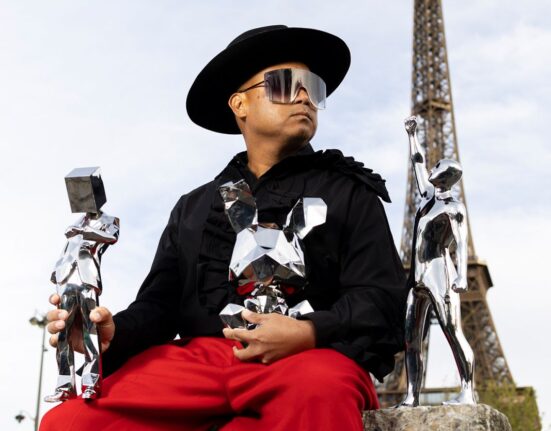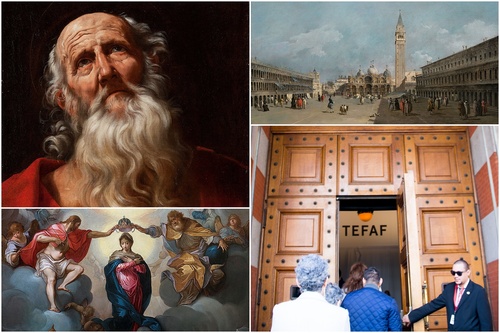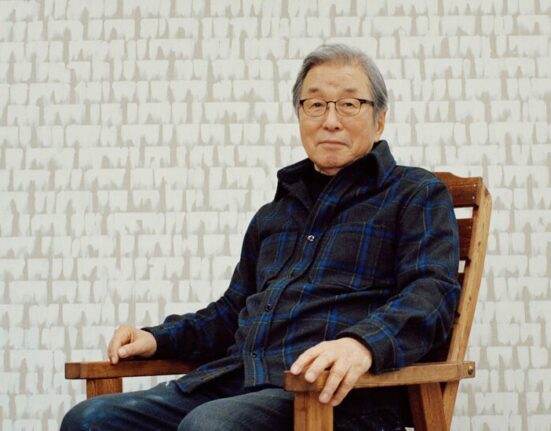Art Market
Paul Laster
Booths at the 2022 edition of TEFAF Maastricht. Image courtesy TEFAF.
Touting itself as the world’s leading art and antiques fair, The European Fine Art Fair—popularly known as TEFAF—delivers on its branding by consistently offering world-class works, and this year is no exception.
Presenting some 7,000 years of art, the 2022 edition of TEFAF Maastricht opened the doors on Friday, June 24th, to a savvy crowd of curators, critics, and collectors who were excited to see the beloved art fair return in real life after a two-year hiatus caused by the COVID-19 pandemic.
Descending on this medieval Dutch city through June 30th, 270 exhibitors from 20 countries are offering a vetted selection of top-quality antiques, tribal arts, rare books and manuscripts, jewelry, Old Master paintings and sculptures, and modern and contemporary art and design.
TEFAF Maastricht has once again delivered the goods across the many categories it highlights. In the realm of modern and contemporary art, here are our five favorite museum-quality paintings from this year’s fair.
Willem de Kooning, Untitled (Woman), ca. 1966
Ben Brown Fine Arts
Willem de Kooning, Untitled (Woman), c. 1966. © The Artist. Photographer: Benjamin Huggard. Image courtesy of Ben Brown Fine Arts.
Willem de Kooning’s Untitled (Woman), a painting on paper from around 1966, belonged to the celebrated singer Andy Williams. He had a formidable collection of modern and contemporary paintings, including canvases by Pablo Picasso, Jean Dubuffet, Helen Frankenthaler, Richard Diebenkorn, Ed Ruscha, and Jean-Michel Basquiat, but de Kooning was among his favorite painters. The painting’s current owner, who consigned the lively abstraction of a reclining nude to Ben Brown Fine Arts, purchased it from Williams’s estate sale at Christie’s in 2013, a year after the “Moon River” crooner’s death.
“It’s a painting on paper, but it’s really thick paint; it’s not simply a pencil or watercolor sketch on paper,” Ben Brown told Artsy at the fair’s VIP preview. “It’s a proper painting of a reclining figure with a mouth, face, and body, and it’s got all the fire of de Kooning’s ‘Women’ series.”
Painted wet on wet in oils with dynamic, overlapping brushwork, it’s a gem of an Abstract Expressionist painting priced at $2.5 million, which is far below what a similar work on canvas by the artist would cost.
Giorgio de Chirico, Il Ritorno del figliol prodigo, 1924
Dickinson
Giorgio de Chirico
Il Ritorno del figliol prodigo (The Return of the Prodigal Son), March 1924 (recto), 1924
DICKINSON
Arguably the most significant modern painting at the fair this year, Giorgio de Chirico’s metaphysical Il Ritorno del figliol prodigo (“The Return of the Prodigal Son”) was commissioned by the Surrealist poet Paul Éluard and his wife, Gala (who later married Salvador Dalí), in 1924 as part of their purchase of 16 paintings by de Chirico when they visited the artist in Rome.
The Éluards asked de Chirico to make a new version of a canvas from 1922 that had been based on a biblical theme. Yet what makes this painting more remarkable is that the artist—lacking the money to buy canvas—painted it on the back of an important earlier canvas, Mercurio e i metafisici (“Mercury and the Metaphysicians”), which depicted a classical subject rendered in the manner of a Renaissance master, a style that he would explore again in later works.
“After consulting Paolo Baldacci, the world’s authority on de Chirico, we know of only one other example of a double-sided de Chirico canvas, which was painted after this one,” said Emma Ward, Dickinson’s managing director. “The de Chirico is an exciting work and we’ve worked long and hard to bring it to TEFAF.”
Priced in the range of €12 million, this marvelous masterpiece, with a prominent provenance (besides the Éluards, it was owned by Umberto Agnelli and has been in a private Swiss collection since 1995), would be a meaningful addition to any museum’s collection.
Wols, Le Tourbillon, 1947
Galerie Karsten Greve
Wols, Le Tourbillon, 1947. Photo: Stefan Altenburger, Zürich. Courtesy Galerie Karsten Greve St. Moritz, Paris, Cologne.
An influential artist in Europe but lesser known in the United States, Wols (1913–1951) was a pioneer of lyrical abstraction. As a painter and printmaker, he made significant contributions to Tachisme, a French style of abstract painting popular in the 1940s and ’50s that was part of the larger European post-war movement known as Art Informel, which included such artists as Jean-Paul Riopelle, Hans Hartung, and Georges Mathieu.
Born Alfred Otto Wolfgang Schulze, Wols first made a name for himself as a photographer in his native Germany before moving to Paris, where he changed his name and medium. Developing a gestural style of abstraction that involved staining, rubbing, scratching, and dripping paint onto paper and canvas in highly controlled ways, he became influential to a new generation of non-objective artists. During his short lifetime, he exhibited with the legendary Galerie René Drouin founded by Drouin and Leo Castelli in 1939; the gallery later published a catalogue of his work with an essay by Jean-Paul Sartre.
“Wols made only 73 paintings,” said Karsten Greve, whose gallery is offering the work at TEFAF Maastricht. “I have sold 20 to museums and I know where most of the others are located. There are only about 10 paintings on the market, so having one is super rare. In my collection, I have a Wols hanging close to a Pollock. Wols was the artist who wanted to create a new world in Europe after the war. In Paris, he was in the first shows at Galerie René Drouin, a very important gallery, and every young artist was running there.”
A mesmerizing painting, which is small yet in the scale of most of his canvases, Le Tourbillon (“The Whirlwind”) is made up of circular brushstrokes on a lightly rubbed surface, where the layers of activity are matched by layers of thought. For sale by Greve—who has a substantial collection of the artist’s work and one the largest archives of Wols materials—at €2.9 million, it’s a must-have painting for a connoisseur of improvisational art.
Sonia Delaunay, Portugaise aux fruits, 1915–16
Galerie Zlotowski
Sonia Delaunay, Portugaise aux fruits, 1915–16. Courtesy Galerie Zlotowski, Paris.
The Ukrainian-born French modernist Sonia Delaunay is better known than Wols by American audiences than those of Europe; New York’s Museum of Modern Art owns more than 50 of the artist’s paintings, drawings, and prints. A co-founder (with her husband, Robert Delaunay) of the art movement Orphism—a form of Cubism with bright colors—she took her practice beyond painting to create textiles, fashion pieces, and set designs.
Portugaise aux fruits (“Portuguese Woman with Fruits”), a painting from her Spanish and Portuguese series, which she made while she and her family took refuge in Spain during World War I, captures a woman in the market from a sketch the artist made on site and then turned into a colorful canvas in her studio. A build-up of vibrant marks, it magically moves your eye through the composition, slowly bringing the figure to life.
“With Delaunay, the figure disappears—the body disappears—it melts into the color,” said gallery owner Yves Zlotowski. “What really stays is the color interaction and the shapes. The round shapes are very important to her work. It’s almost an abstract work, although it comes from a figurative subject. It’s always that way with Sonia’s and Robert’s work—it’s always about how the colors and shapes will affect the viewer.”
A rare painting on the market, as most of the works from this series reside in museum collections, it is reasonably priced at €470,000.
Francis Picabia, Untitled (La Magie du hasard), 1948
David Lévy & Associés
Francis Picabia, Untitled (La Magie du hasard), 1948. Courtesy David Lévy & Associés, Brussels.
A leading light of the Dada and Surrealist movements, the French avant-garde artist Francis Picabia also made works in a variety of other artistic styles, including Impressionism, Cubism, and abstraction while anticipating the Pop, Conceptual, and Postmodern art movements of the latter half of the 20th century. Picabia’s paintings and drawings of the 1930s and ’40s greatly influenced later generations of contemporary artists. He made Hollywood starlets the subjects of his penciled portraits long before Andy Warhol embraced Marilyn Monroe and Elizabeth Taylor, and turned Sigmar Polke and David Salle on to new ways of visually layering the female figure.
Picabia’s abstract painting Untitled (La Magie du hasard) (Untitled [The Magic of Chance]), from his short-lived and less productive Art Informel period, recalls canvases and drawings from his Dada days, with mechanical forms floating on an indistinct ground. Looking somewhat like a traffic light and flags viewed on a city street from below, it’s composed with thick strokes of paint that reveal the expressive touch of the brush.
“After World War II, the only real option available to European artists was to turn to abstraction, and Picabia chose this path as well,” said Joséphine Balloul, director of David Lévy & Associés. “The paintings are both mechanical and organic, and he was using a lot more paint on the surface of the canvas. We acquired it from a private collector in Paris.”
Priced at €750,000, it’s well below his nearly $11 million auction record, achieved for one of his transparency paintings at Sotheby’s in Paris in March of this year, but a strong example of his lesser-known later works.







